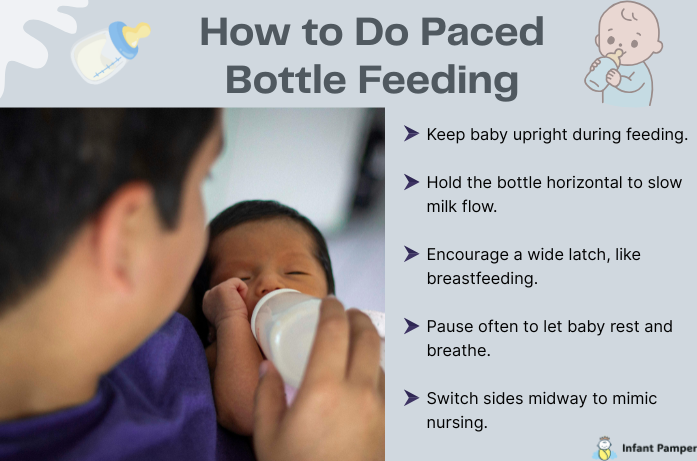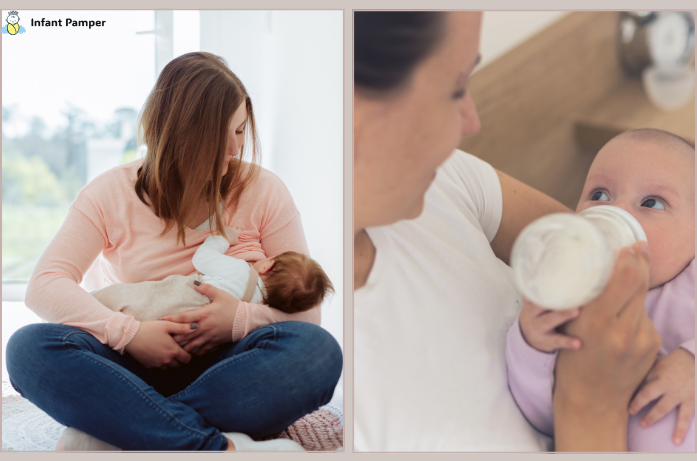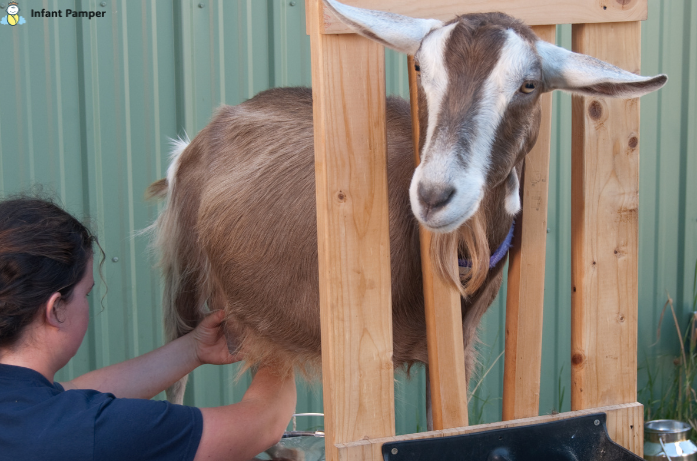Welcoming a newborn into your world is magical and so are the questions that come with it, especially about feeding. One of the most common concerns new parents face is how to bottle feed a breastfed baby without disrupting the bond or routine of breastfeeding. Whether you’re preparing to return to work, need to share feeding duties, or simply want to introduce flexibility, learning the right way to transition from breast to bottle is key.
At Infant Pamper, we celebrate every form of feeding and offer gentle, expert-backed guidance to help you make this shift with confidence, care, and love ensuring your baby stays nourished and content every step of the way.
Why Would You Bottle Feed a Breastfed Baby?
A few reasons why parents want or need to bottle-feed their babies include:
- Going back to work or school
- Offering the partner or caregiver a chance to share in feeding duties
- Providing the breastfeeding parent with some flexibility or breaks
- Medical needs or medication considerations
- For future weaning or transitioning needs
It is the effort you put into your child that really counts; no matter the reason for you doing what you are doing.
When Is the Right Time to Introduce a Bottle?
Timing should always be considered. Experts like the American Academy of Pediatrics (AAP) recommend that your baby should be accustomed to breastfeeding for about three or four weeks before introducing a bottle.
Too early gives the risk of nipple confusion. Too late means baby will be reluctant to try something new altogether. The best option is to wait once your baby latches well, you are an adequate milk producer, and you feel comfortable with consistent breastfeeding.
Common Fears: Nipple Confusion and Bottle Preference
With the term “nipple confusion” being thrown around, many parents think their babies cannot be switched back to breast. However, in most cases, babies tend to be quite adaptable, as long as the bottle feeds resemble breastfeeding closely.
The far more common problem is referred to as “nipple preference.” If the milk flows faster and requires less work, babies tend to favor the bottle. This makes paced bottle feeding all the more important because it tries to keep the experience as close to breastfeeding as possible, thereby supporting the balance between the two.

How to Do Paced Bottle Feeding
Paced bottle feeding mimics breastfeeding and allows the baby to control the pace of feedings. It helps to prevent overfeeding and supports the breastfeeding relationship.
Steps for paced bottle feeding:
- Hold baby upright, not flat.
- Hold the bottle horizontally (parallel to the floor).
- The baby needs to latch onto the bottle nipple just as they do for the breast.
- Let the baby take short breaks after every few sucks.
- Switch sides halfway through (again, just as if actually breastfeeding).
This type of feeding creates slower paced feeding where a baby has to work for milk just as that is done at the breast. The Academy of Breastfeeding Medicine (ABM) recognizes paced bottle feeding as one of the safest techniques to preserve breastfeeding.
How to Choose the Right Bottle and Nipple
Although Infant Pamper doesn’t recommend any brands, here is what to look for when buying a good bottle for breastfed babies:
- Slow flow nipples: Mimics milk flow at the breast and prevents any preferences.
- Wide base nipples: Supports an oral pattern for latching that is similar to the breast.
- Anti-colic design: Allows minimum ingestion of air, which is sometimes blamed for gas or fussiness.
Avoid fast-flow nipples during these initial days of giving the bottle, as this may frustrate the baby from breastfeeding, which requires greater effort.
Who Should Offer the Bottle First?
Sometimes babies associate mom with the breast and may show their resistance to mom’s bottle. Hence, this is where having another caregiver, partner, grandparent, or sitter come into play to feed that first bottle.
Also, stay out of the room. Babies can smell mom’s milk and may refuse bottles if the “real thing” is nearby!
Tips to Successfully Bottle Feed a Breastfed Baby
Here are some gentle, rock-solid tips that might help this transition go just a little smoother:
- Start slow: Introduce one bottle feeding session per day only.
- Offer when baby is calm, not starving: A relaxed baby will be more willing to try something new.
- Expressed breast milk: The taste is familiar and comforting.
- Warm the milk to body temperature: Babies usually prefer it that way.
- Keep trying, gently and patiently: It might take a couple of tries before the baby accepts it.
Building a Routine That Works for You
Once bottle feeding is established, you can gradually increase the number of bottle feeds at your discretion. Some families use bottles throughout the day and breastfeed at night. Others halfway bottle and halfway breastfeed. There is simply no one “right” way.
Connection is more important than anything else, nourishment, and bonding-the whole shebang, wherever possible, while nursing or bottle feeding in your arms.
What If Baby Refuses the Bottle?
This is quite common, especially if your baby is big or very attached to nursing. Here’s what you can work with:
- Try different nipples (some are softer, some are more breast-like)
- Offer at different times of day
- Offer when the baby is somewhat sleepy
- Walk or rock during feeding
- Stay calm: Babies pick up on stress
If this continues for several days or weeks, consult a lactation consultant or pediatrician. You’re not alone.La Leche League International (LLLI) provides excellent resources for parents facing these challenges.
Balancing Breast and Bottle
Many families combo-feed, meaning they use both the bottle and the breast. This can work beautifully if:
- You keep regular breastfeedings
- Pump to keep your milk supply stable
- Bottles are introduced as a complement to breastfeedings, not replacing them entirely
A lactation consultant can assist you in designing a feeding schedule that accommodates both means of feeding.
Important Safety Tips for Bottle Feeding
- Always make sure that the temperature is acceptable to the baby before offering the milk.
- Discard anything that remains in the bottle following feeding.
- Wash the bottles and nipples properly.
- Go for the BPA-free bottles!
- Never prop the bottle; always hold your baby while feeding.
The Centers for Disease Control and Prevention (CDC) also reminds parents that good hygiene and cleaning practices are essential in preventing infections in newborns.
Final Thoughts: Love Over Method
Whether at the breast, bottle-fed, or both, you are doing a wonderful job. What’s important is that babies are fed, loved, and growing well.
There is no perfect way to go. It is a road that works for you and your family. And while feeding, your baby receives more than milk: your eyes, your voice, and your heart-which is inimitable.
FAQs
Q1. Does bottle feeding harm breastfeeding?
Sometimes yes, sometimes no. When bottle feeding is introduced after breastfeeding is well established and paced feeding is carried out, most babies are able to switch back and forth breast-bottle successfully.
Q2. How often should a bottle be put in for a breastfed baby?
Start with one bottle a day or a few times a week. Gradually adjust based on your family’s needs and your baby’s comfort.
Q3. My baby refuses the bottle. What can I do?
Hang in there, it is a little trial and error with the shape of the nipples, and by general convention, the bottle has to be offered by a different caregiver. Sometimes it helps when offered while the baby is calm or slightly sleepy.
Q4. Can I put formula in the bottle if I´m breastfeeding?
Yes, indeed. Some families combo-feed; they alternate between sending breast milk and formula to their babies within the same feeding session. But, if you are thinking along these lines, consider speaking with your pediatrician to ensure that your baby would get all the necessary nutrition.
Q5. Should I sterilize the bottles all the time?
Yes – sterilizing is recommended for newborns below 3 months accelerated babies or with health issues. For older babies, it is generally all right to wash bottles thoroughly with hot soapy water.
Disclaimer: This article is for informational purposes only and is not a substitute for professional medical advice, diagnosis, or treatment. Always consult your pediatrician or a certified lactation consultant for personalized guidance regarding feeding your baby.
At Infant Pamper, we understand that every feeding choice is an expression of love. For gentle guidance and support from parent to parent, dive into our full parenting guide library. Because at Infant Pamper, parenthood meets sound advice and warm care.
Follow Infant Pamper for daily parenting tips, guides, and gentle support through every stage of your baby’s growth.




